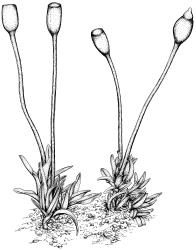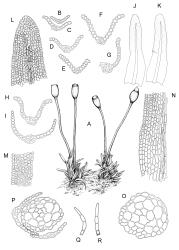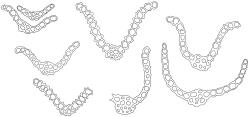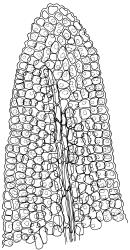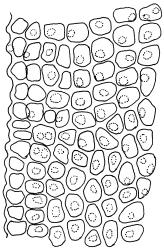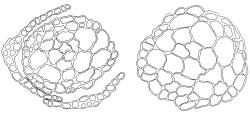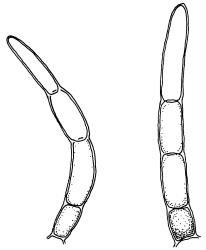- ≡ Didymodon novae-zelandiae J.E.Beever & Fife, Phytotaxa 258: 279 (2016)
Plants minute, brown-green, gregarious. Stems c. 1–2 mm, simple or sparsely branched, in cross-section without a central strand or sclerodermis. Leaves erect-spreading when moist, imbricate and appressed-incurved when dry, 0.5–1.0 mm, lingulate, carinate, rounded and ± flat at apex; margins plane or very weakly recurved at mid leaf, crenulate by bulging cells and rounded papillae; upper laminal cells clear in outline, irregularly rounded sub-quadrate to oblate, firm-walled, bulging, with one or two low, rounded, simple papillae, (7–)7.5–13.5(–15) × (7.5–)8–11(–15) µm, becoming longer towards the leaf base; upper marginal cells not differentiated, c. 10 files of laminal cells between margin and costa at mid leaf; lower laminal cells differentiated, ± thin-walled, hyaline, rectangular medially and extending distally adjacent to the costa, becoming shorter towards leaf margins in the leaf base. Costa concolorous, tapered, and failing 6–12 cells before the leaf apex; adaxial superficial cells elongate throughout; abaxial superficial cells quadrate distally; in cross-section cells weakly differentiated. Axillary hairs of c. 4 cells, basal 1–2 usually brown. Laminal KOH colour reaction yellow.
Dioicous. Perichaetia terminal, the inner leaves sheathing the seta base and with a basal zone of thin-walled, lax, elongate cells extending to c. ½ leaf length. Perigonia terminal or on very short branches, on plants smaller than ♀ plants, with stems 0.4–0.7 mm, bracts reddish brown, the largest c. 0.3 mm, lingulate from a broadly ovate base, surrounding c. 2 antheridia and few paraphyses. Setae slender, dark red at base, pale above, 3–6 mm. Capsules short-cylindric, yellow-brown, becoming darker with age, 0.5–0.9 mm. Operculum mammillate. Peristome lacking. Spores (7.5–)10.5–14.0(–19.5) µm, smooth.
Beever & Fife 2016, fig. 2.
In addition to its very small size, this moss may be recognised by its lingulate leaves only 0.5–1 mm in length, with the failing costa and rounded apices characteristic of the genus. The erect eperistomate capsules are held well clear of the leaves on setae 3–6 mm high. The definitive character, however, is the mammillate operculum. Tridontium novae-zelandiae has been confused with Gymnostomum calcareum, from which it differs in the brown-green colour of its shoots (vs yellow-green in G. calcareum), its uniformly rounded leaf apices (vs apiculate, acute, or rounded, even on the same stem, in G. calcareum), red setae (vs pale yellow in G. calcareum), and mammillate opercula (vs rostrate in G. calcareum).
NI: N Auckland (Manukau Harbour), Hawke’s Bay (near Wairoa), Wellington (Mākiekie Scenic Reserve).
Endemic.
On damp, vertical banks, on sea coast or road edge, on a variety of substrates (tephra, fine silt derived from andesitic breccia and sedimentary rock such as papa). Associated mosses include Bryum clavatum, B. dichotomum, Tridontium cockaynei, and T. tasmanicum.
Since the description of this species (Beever & Fife 2016) no further colonies have been found; Tridontium novae-zelandiae remains known from only four sites. Its diminutive size makes detection difficult in the field, but its eclectic range of not uncommon substrates suggests that it may be much more common than present records indicate.



